Salomon Glen Coe Skyline Q&A
14th Aug 2015
The original version of this Q&A was published on the UK’s leading outdoor website UKHillwalking (March 2015), albeit, the Q&A was edited by UKH. We are now publishing the full text, which has been added to since then, to reflect the updates in the event planning, and to address the most frequently asked questions. We are also releasing further details of the safety measures that will be employed during the event.
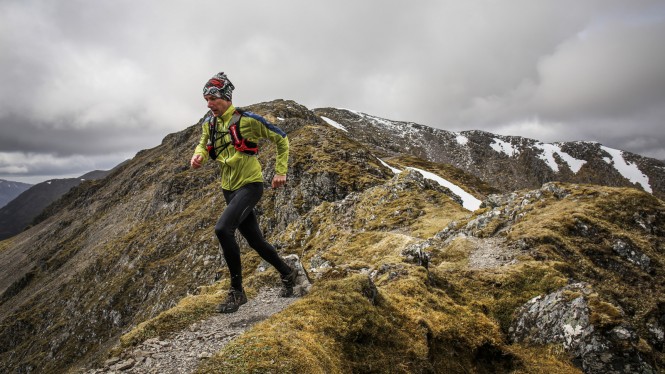
Es Tresidder running along the Aonach Eagach, Glen Coe © Ian Corless
UKH Question: “What, in layperson’s terms, is the definition of a Skyrunning race?”
Skyrunning has been evolving rapidly in recent years so please allow me to explain some background context.
Skyrunning was the brainchild of Italian mountaineer Marino Giacometti, who, with a handful of fellow climbers, pioneered records and races on Mont Blanc and Monte Rosa in the Italian Alps in the early ‘90’s. In 1993, with the support of the multinational Fila as sponsor, Skyrunning took off across the world’s mountain ranges with a circuit of awe inspiring races stretching from the Himalayas to the Rockies, from Mount Kenya to the Mexican volcanoes.
Giacometti’s term ‘Skyrunning’, as the name suggests, is where earth and sky meet and that is precisely what a classic Skyrace does; race along the ridges and mountain tops.
Marino Giacometti’s vision didn’t stop there and in 1995 he founded the Federation for Sport at Altitude (FSA) to address the need for rules to govern the sport and generally manage this fast-growing discipline, which today counts some 200 races worldwide with around 30,000 competitors from 54 countries. Today, the sport is managed by the International Skyrunning Federation, which took over from the FSA in 2008.
There is a World Series, Continental Series and many National Series and three classes of races including: Sky (typically less than 45km), Ultra (typically greater than 45km) and Vertical Kilometer (one kilometre of ascent). Both the Sky and Ultra category races have very significant ascent of many 1000’s of metres.
Within this International collection of different races there is great variety in the technical nature and terrain. It would be fair to say that the Salomon Glen Coe Skyline™ is pitching itself at the very top of the pyramid in terms of technical difficulties and seriousness of the terrain.
It is important to realise that the standard within International mountain running has progressed rapidly in recent years and this has been driven to a large extent by the explosion of popularity in Skyrunning. The most challenging Skyraces have moved far beyond what the lay person would consider a typical fell or trail race as seen in the UK. However, it is important to add that competitors at the Salomon Glen Coe Skyline™ are not new participants to mountain sports, rather they are experienced mountain runners and climbers who have chosen to participate in a different activity – we are not adding new participants, with additional pressures, to the mountain environment.
The Salomon Glen Coe Skyline™ is part of the UK Series in 2015.
UKH Question: “Has a route this technical ever been put on in the UK before, to the best of your knowledge?”
No.
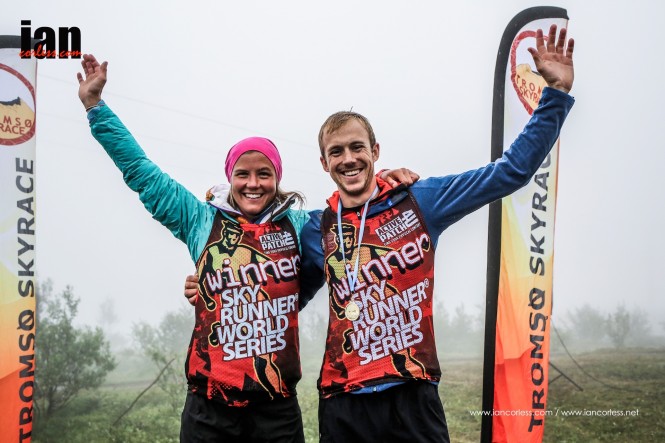
Tromso 2015 Skyrace winners: Emelie Forsberg and Jonathan Albion ©iancorless.com
UKH Question: “And overseas?”
Yes. Races like the Tromso Skyrace, Dolomites Skyrace, Trofeo Kima and the 3 Refugio’s all have very technical sections in serious mountain environments, which would be equivalent in nature and risk to the terrain encountered on the Salomon Glen Coe Skyline™ route. What we are doing is not without precedent.
UKH Question: “What are the particular challenges it throws up for you as the organiser?”
There are many challenges but the safety of the event staff and competitors is always our first consideration and I will talk more about the management of risk further on. From an organisational and logistics perspective, the big challenge is marking the route and choreographing the event team into the right locations, at the right time, to support the race as it unfolds.
There will be two routes, the primary route and a bad weather route, and the plan is to wait until the last possible moment (so that we make our decision based on the best weather forecast) and then to use multiple teams of very experienced people to mark overlapping sections of the route.
Of course, there are many other logistics to deal with as well the waymarking to ensure that the event runs smoothly!
UKH Question: “What is the ideal skill set for a prospective competitor?”
Clearly they need to be an experienced mountain runner with sufficient experience of technical, rocky terrain that they can solo Moderate standard rock climbs (scramble grade III / IUAA II) in all but the most severe weather conditions.
UKH Question: “How many top runners have sufficient climbing background, do you reckon?”
Honestly, I am not sure but we’ll find out in August! The thing to remember is that this race is aimed at an international clientele so the potential pool of competitors is larger than just the domestic UK audience. I’d anticipate participation in year one being low, and made up of mostly UK based runners, and we’ll take it from there.
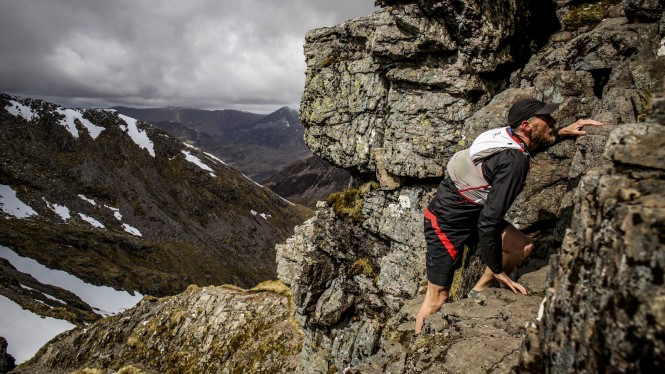
Gary Tompsett negotiates a tricky step on the Aonach Eagach, Glen Coe © Ian Corless
UKH Question: “What are your vetting criteria? I’ve seen the declaration of competence, which all seems very sensible: but how can you be sure an applicant really has a realistic grasp of the demands of this course, and an honest appreciation of their own abilities?”
Thanks for describing it as sensible! We thought carefully about that. The vetting process includes the requirement that:
“Aspirant competitors must provide evidence of the completion, within the last 5 years, of a mountain run or race of similar severity to the Salomon Glen Coe Skyline™.”
If someone needs to ask us whether their running experience is similar in severity to the Salomon Glen Coe Skyline™, then they probably don’t have the right experience to make a judgement about their own abilities.
Competitors must also agree to a very strong statement (the Declaration - HERE) that emphasises the risks of participation and makes the type of experience required from competitors crystal clear.
We can never be 100% certain that everyone provides 100% truth on their race application form, but in my experience very few competitors lie and those that do are usually comically obvious and nearly always claim to also be ex-SAS!
Obviously there is a need to communicate the Nature of the Challenge clearly and unambiguously to the competitors and to do our best to ensure that they understand precisely what they are committing to and we make this clear in all the pre-event information on the website, emails, news stories and disclaimers and declarations that each competitor must agree to.
UKH Question: “How many people do you think will enter?”
For planning purposes I have assumed between 100-200. The higher figure allows us to stress test the event plans as they are, and the lower figure is probably a more realistic expectation.
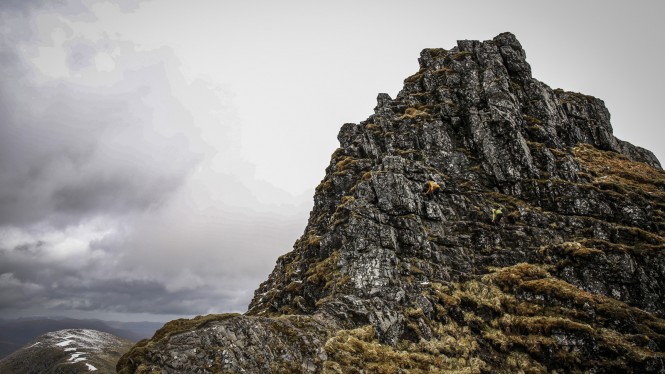
Es Tresidder and Finlay Wild scrambling a difficult traverse on the Aonach Eagach, Glen Coe © Ian Corless
UKH Question: “Can you describe the provisional route, and explain the thinking behind it? It looks like you’re missing out Buachaille Etive Beag for instance – would that just be a ridge too far, even for this event?”
Ah… Buachaille Etive Beag, whether to include this or not is one of the questions we have been considering!
Before describing the primary route let me just explain that we have two routes. The primary route is as described on the website and below but there will also be a bad weather course. We won’t finalise the details of either course until the spring when the snow has melted and we can finish the risk assessing started in the autumn. The approximate minimum distance and height gain for our primary course is 45km with 4,500m of ascent. Gary Tompsett, our course planner, describes it below:
“With a route that dances along the jagged and lofty mountainous horizons above Scotland’s most famous Glen and Pass, and with airy ridges to negotiate, there is no doubt that this race has a license to thrill. Glen Coe has long held travelers in awe. It is described and known by the characteristic shapes of each individual mountain along its length, and by the essential and ancient passage of the roads below. The mountains dominate and tower over anyone that stands below them, or who passes along the present A82 road, necks craning to see the tops.
This Skyrunning race is based at the popular Glencoe Mountain Resort (alt 360m) at the foot of Meall a’ Bhuiridh – part of the Black Mount, and incorporates the West Highland Way Long Distance Route as a conduit to and from the foot of these dramatic mountains.
The classic triangle of Stob Dearg (Buachaille Etive Mor) is a sentinel to the eastern entrance to the Glen, and backdrop for the event venue, and the first few kilometres. The West Highland Way will take you to the settlement of Altnafeadh (alt 290m), our divergence from the Way and onto the steepening open hillside. Summiting Stob Dearg (alt 1022) by either the exposed Grade III scramble (a 'Moderate' graded rock climb) of Curved Ridge, or by the path in Coire na Tulaich (the bad weather route). At the summit, a vast view eastwards to Rannoch Moor is presented. The route then heads southwest along the multiple summits of the Buachaille Etive Mor massif before dropping rapidly into Lairig Gartain (Pass alt 370m), crossing the River Coupall and immediately ascending to the Buachaille Etive Beag col and dropping down the other side.
Now passing through increasingly remote territory, it is time to descend to Lairig Eilde (Pass alt 490m), and immediately then ascend onto the shoulder of Stob Coire Sgreamhach, before summiting at 1072m. We are now on the highest and most complex terrain of the whole route, and soon reach the summit of Bidean nam Bian (alt 1150). We are considering a dog-leg to Stob Coire nan Lochan (alt 1115m) to enable competitors to experience another mountain spur into Glen Coe – it’s a stunning environment here. Returning to the summit of Bidean then enables descent using regular paths to the A82 road at 90m – the lowest point of the route.
Above us now, remains a stiff ascent to the famous Aonach Eagach ridge, an arête with occasional Grade II scrambling, and for us it extends west to east from Sgorr nam Fionnadh (alt 967m), over Meall Dearg (alt 953m) to Am Bodach (alt 943m). That is 3km of intricate ridge traversing, with distant views over the coastline and hundreds of mountains including Ben Nevis. The ridge continues over smaller summits and flowing ridges until descending a shoulder to the West Highland Way. The superlatives don’t cease here though. Cresting the summit of the path (alt 540m) brings us to a renewed view of our sentinel mountain, and the final descent of the Devil’s Staircase, an exciting sequence of switchbacks to the A82 at Altnafeadh (alt 290m).
The West Highland Way outward route is then reversed to return to Glencoe Mountain Resort and the Finish.”
Back to your question regarding Buchaille Etive Beag. We shall not traverse the whole Buchaille Etive Beag ridge with its two munro summits as, after much consideration, we think the route is hard enough as it is.
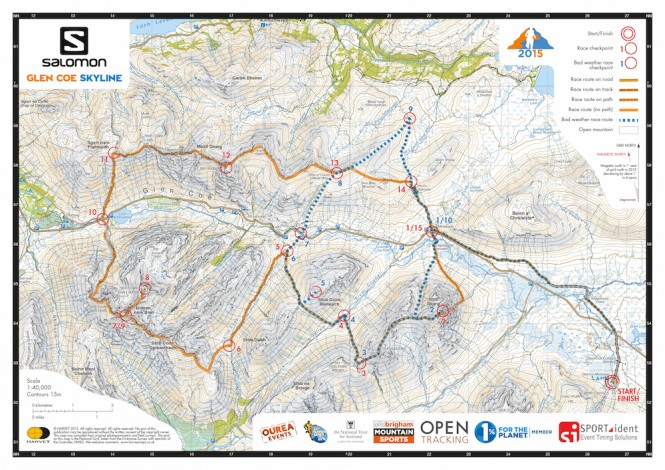
UKH Question: “No fixed ropes – so what safety measures will you have in place on the crux sections?”
Before getting into this specific detail I’d like to explain my approach to risk more broadly. It is important to understand that I am not trying to create a risk free activity. Take motor racing or cycling for example, everyone understands that there is an element of risk when participating in these sports but very few people would argue that they should be banned because they are inherently dangerous. Within these sports, the organisers take certain measures to mitigate risk without altering the fundamental challenge, for example, both sports require competitors to wear helmets whilst competing but competitors still race around the course as fast as possible.
For the Salomon Glen Coe Skyline™ competitors will also race round the course as fast as possible and that is the Nature of the Challenge. This phrase, the Nature of the Challenge, is very important and I often return to this concept when deliberating about the details of an event. The Nature of the Challenge for the Salomon Glen Coe Skyline™ is to complete a very challenging mountain course as fast as possible, and this will require a combination of running and climbing skills and experience. As the race organiser, it is my role to put in place the logistics and support to make that happen without ‘designing in additional risk’. The notation of ‘designing in additional risk’ is also important.
For example, the Salomon Glen Coe Skyline™ route will ascend Buachaille Etive Mor via Curved Ridge (Moderate) and this is part of the Nature of the Challenge. However, if the optimum course actually meant that competitors would be tempted or could choose to ascend via nearby Grooved Arete (Very Severe) instead that would be ‘designing in additional or unnecessary risk’ through poor route management.
I understand that these are nuanced considerations but it is something that both Gary Tompsett and I consider very, very carefully.
Back to your original question: there are currently no plans to have any fixed ropes on the crux sections of the route and this is in keeping with the Nature of the Challenge as described. However, we have developed some innovative techniques for dealing with the most serious risks on Curved Ridge (with a similar approach to some sections of the Aonach Eagach ridge) including using professional mountaineering instructors to provide advice and assistance to the participants (if required), including roped assistance for nervous runners in the most difficult sections of the race route.
Common Question: “Why not release details of these additional safety measures when you announced the race?”
This approach is deliberate and considered. We did not want to encourage entries from ‘marginal’ competitors who may have – incorrectly – thought that, because of the various safety measures deployed, they would be OK to ‘have a go’. The Salomon Glen Coe Skyline™ is definitely for experienced mountain runners who also have some climbing experience (or vice versa) and this is reflected in the cohort of entries we have.
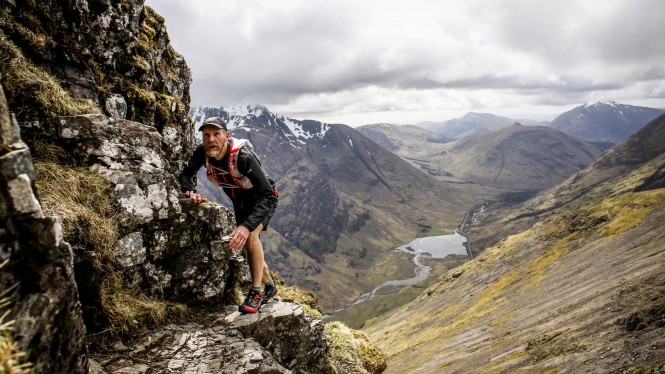
Gary Tompsett negotiates another tricky step on the Aonach Eagach, Glen Coe © Ian Corless
UKH Question: “The danger of a serious accident on this event seems higher than average: does that worry you?”
The instinctive reaction of many people to the Salomon Glen Coe Skyline™ is that the risk of an accident is higher than average. However, this is not necessarily correct and I would argue that whilst the consequences of an accident are higher than average, the risk of that accident happening in the first place remains average because of the vetting process, robust race management, and the advanced experience, skills, care and dexterity that the competitors will possess.
The experience of the competitors themselves, to the extent that they may even choose not to participate, is the single most important factor when considering event safety. My experience at other challenging events demonstrates that, with a good vetting process and clear pre-event information, you can trust that the competitors on the start line are informed, experienced and capable of participating within acceptable safety boundaries given their experience.
I’d like to reiterate that I am not trying to create another fell or trail race, but bring world class Skyrunning to the UK with a course that has world class difficulties. It is not meant to be easy and a course of this caliber has inherent risk… back to the Nature of the Challenge.
At all my events there is constant underlying stress about the safety of the competitors and event staff and the Salomon Glen Coe Skyline™ will be no different. I do not relax until robust event management plans are set, and everyone is safely accounted for at the end of event.
Common Question: “If there is an accident, shouldn’t the participant or event organisers pay for the bill for any rescue and medical care?”
I am totally happy for this to happen when the same applies to everyone else! For example, the many experienced hill walkers, mountaineers and climbers who each year require the help of mountain rescue and the emergency services. I think that, as a society, if we go down this route, it would only be fair to also charge reckless motorists or binge drinkers for the cost of rescue and medical treatment…etc, etc.
UKH Question: “How have you managed to get insurance cover for the event?!”
For each of the Ourea Events races we produce a very detailed ‘Event Handbook’ that provides a comprehensive and detailed plan for who is responsible for what, when and how, method statement, risk assessments and much more. Various insurance companies have praised this document over the years. In fact, when was I seeking insurance in 2014 for the business, one of the underwriters offered me a job risk assessing for them! To answer your question, we have insurance for the event and it has not been difficult to obtain… but it is pricey!
UKH Question: What form will the waymarking take?
The different sections of the route favour different approaches and we intend to use a variety techniques learnt from many previous events including marker tape, stone-weighted-baskets, signs, flags and personnel. All the waymarking will be removed immediately after the race.
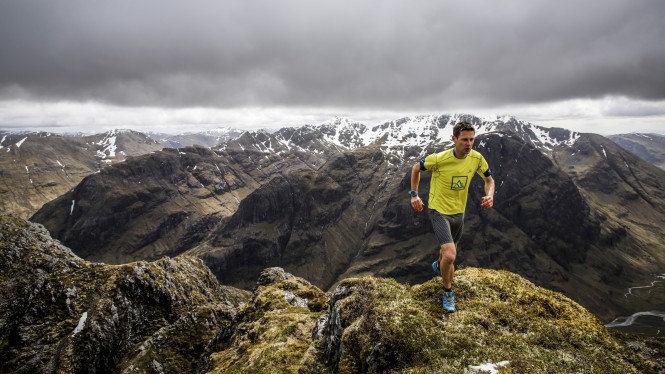
Shane Ohly running along the Aonach Eagach with the Bidean Massif behind © Ian Corless
UKH Question: “I’d have thought there was potential for bottlenecking on AE and Curved Ridge, if your competitors are trying to share the route with random members of the public: are you planning to mitigate this in any way?”
Yes and yes. It is important to consider the impact of the event on other recreational users of Glen Coe. In fact this was the first question asked by the National Trust for Scotland (NTS) who are the major landowner. Gary Tompsett and I have plenty of experience of mitigating an event’s impact on other recreational users and we were able to reassure the NTS that we will have robust plans and processes to achieve this. These will include timing, directions and interaction by skilled mountain personnel in crux areas. Although the minds-eye and common terminology conjures knife-edge-arêtes, there is in fact a lot of space up there!
In more detail, we will place public information signs in Glen Coe (at car parks and the approach paths) one week before the event informing members of the public about the event and the route. We actually hope that members of the public will not find the event any imposition, but rather enjoy seeing the endeavors of the participants and give them a warm welcome, whilst cheering them on, as is the case in Europe.
The participants will be strongly briefed that they should remain polite and courteous to all other recreational users that they encounter, and that they have no more than an equal right of way. Obviously, we hope that members of the public extend the same courtesy to the participants!
I competed in the Tromso Skyrace (in Norway) recently and, even on the steepest and most technical part of the course, local hikers were sharing the mountain and encouraging the competitors – a very positive experience for everyone.
There will also be approximately 40 event staff deployed to the course and they will be able to advise members of the public about the presence of the participants and the precise timings when members of the public may encounter the runners.
Finally, the actual race route in terms of timings and direction of travel has been very carefully considered. The first potential bottleneck is Curved Ridge but the 0700 start means the competitors will arrive here at 0730 in the morning, well before most climbers are likely to be on the route. The next potential bottleneck is Aonach Eagach ridge and although our competitors will be on the ridge at a popular time they will be travelling west to east i.e. approaching most people (east to west is most popular with hikers) so that both competitors and members of the public have sight of each other as they approach. They will also be highly dispersed at this stage of the race or in very small groups. There will also be event staff at each end of Aonach Eagach ridge and at key technical sections. These event staff will able to provide advice and assistance if required and reassure members of the public.
NTS have been very supportive of the event and have provided guidance on issues such as this during the planning process.
I would just like to add that each year Ourea Events™ (the company organising the Glen Coe Skyline™) donates 1% of its total sales to charitable environmental organisations at the forefront of the protection of the mountain environment. The business has been a member of 1% of the Planet since day one because, whilst we always seek to mitigate our environmental impact, we understand that we do still have an impact.
UKH Question: Have you or Gary run the skyline in a one-er yourselves?
No. But between us we have direct personal experience of the majority of the race route over the years, including multiple ascents/traverses of Curbed Ridge and AE Ridge, and in fact Gary has been course director of two adventure races that had hill stages on these ridges (in 2005 and 2007). However, one of the reasons that we are delaying final conformation of the route is that we must return to some key locations and re-assess the risk from an event organisers perspective rather than relying on knowledge and experience gained from recreational visits in the past: you just think differently about the competitors experience when you stand on the spot as an event organiser and ask the difficult questions. We also have to be open-minded during these safety assessments – there could be route sections that, under certain conditions, are more precarious than these Ridges.
I do like the idea of running the entire route myself though… and I’m not the only one judging by the excited emails I’m getting from aspirants!
Update: Gary waited for some particular poor weather to complete the full ‘bad weather route’ on the 1st August in one go. Both Shane and Gary have since completed the full course. Both these outings will be recorded on a GPS and available for competitors to download in advance of the race.
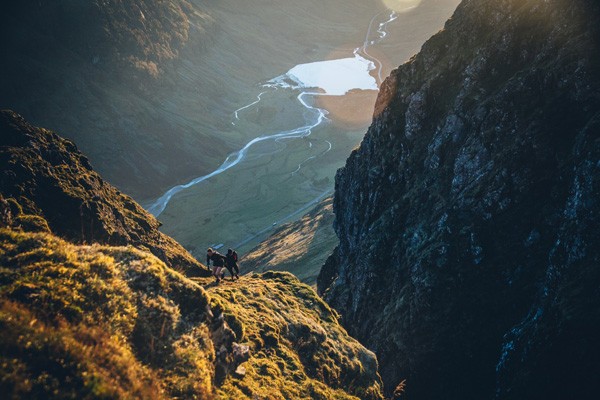
Salomon athletes Rickey Gates and Tom Owens running in Glencoe. © The Africa Attachment
Common Question: Some commentators in both the mainstream and outdoor media have described the event as the ‘Glencoe Death Race’. How do you respond to this?
It is unfortunate that some commentators have decided to adopt an entirely negative approach to reporting on this event. I can accept this sensationalism from an ill-informed mainstream media, but I have been disappointed by some of the reporting from specialist outdoor media. The headline for me is the world-class sporting event that showcases some of Scotland’s finest mountains, which has attracted an incredible field of athletes including the current Skyrunning World and European Champion (Ultra) Emilie Forsberg. Having just returned from the Tromso Skyrunning World Series race, it is clear that the Salomon Glen Coe Skyline™ has created a real stir… it was the talk of the town!
Common Question: Have you not courted this type of media attention with phrases like, “There is danger of serious injury or death” in your terms and conditions and competitor declaration?
Many sporting activities will have terms such as this that people agree to when they participate, it is just that they choose to overlook them. Just have a careful read of the participation statement you sign to enter a climbing wall or a MTB race for example. I would rather be open and honest in my approach to informing potential competitors of the risks than try to pretend the race is ‘safe’. Informed consent from participants is important and, whilst potentially shocking, the terminology is accurate. However, I would like to put this into perspective with some facts from the last 30 years of Skyrunning…
The International Skyrunning Federation is currently compiling comprehensive statistics on the total number of participants in all its sanctioned events but in thousands of races, over 23 years, since 1992 there have been 7 fatalities (or 6 if you don’t count the Malaysian veteran’s data).
Only one of these fatalities was due to an accident, whilst the others were all due to pre-existing medical conditions that were either known or unknown to the competitor. These break down as follows:
Skyrunning World Series
- 2005 - Accident - Kima Trophy, Italy
- 2005 - Heart Failure - Pikes Peak Marathon, USA
- 2012 - Hypothermia - Cavalls del Vent, Spain
- DATE - Heart Failure - Malaysia (in the veteran’s race, not the sanctioned ISF race, but at the same event)
Skyrunning National Races
- 2011 - Heart Failure - Valtellina SkyRace, Italy (not during but after the race)
- 2013 - Heart Failure - Tartufo Ultra marathon, Italy
- 2014 - Heart Failure - Maratona del Cielo, Italy
Contrast that with record of fatalities at road run events, particularly the big city marathons. Tragically four runners died during the 2005 Great North Run but no one called for a road running ban.
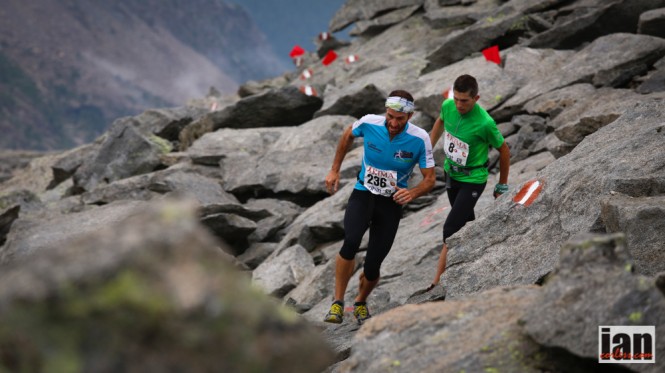
Kima Skyrace 2014 ©iancorless.com
Common Question: That maybe correct but isn’t it simply reckless to organise an event like the Salomon Glen Coe Skyline™?
The crucial distinction here is that the Salomon Glen Coe Skyline™ is not open to the general public. There is a huge difference between offering an ‘extreme activity’ like bungee jumping (for anyone) and organising a sporting event (for a select few). For example, the majority of people who partake in extreme activities do so for a one-off thrill, such as bungee jumping or tandem skydiving whilst on holiday. In this instance, anyone can participate and the participant is total dependant on the provider for ensuring that they remain safe. The participant is unable to make a fully informed decision about participating and they rely on the expertise of others. It could not be more different at the Salomon Glen Coe Skyline™. From the start, the onus has been on the participants to prove that they have sufficient experience and skill to participate. Then each potential competitor is vetted to double-check this (we have rejected about 25% of the entry applications). We are offering a world-class Skyrunning course that only experienced, informed and consenting adults can choose to participate in.
Common Question: “Ok, so the competitors are being vetted but who is vetting you as the organisers? What rules and regulations must you abide by?”
First off, there are no statutory legal requirements on the organisers for a race of this nature in the UK. That said, it does not mean that we do not adhere to very high standards of safety management.
Ourea Events is independently affiliated to England Athletics and we regularly review the good practice guidelines produced by this organisation. We also keep a close watch on the good practice policies of the Fell Running Association (FRA) and in the case of the Salomon Glen Coe Skyline™ we have looked carefully at protocols and good practice from the world of mountaineering and climbing, asking some very hard questions about the relevance and appropriateness of commonly accepted norms (like wearing a helmet).
We have sought out the views of local mountaineering experts and, whilst these have been challenging at times, we have listened carefully and made considered judgments on how good practice from many different areas can be combined to best effect at the Salomon Glen Coe Skyline™.
Finally, the event is sanctioned by the International Skyrunning Federation (ISF) who provide another layer of expertise and oversight to our planning.
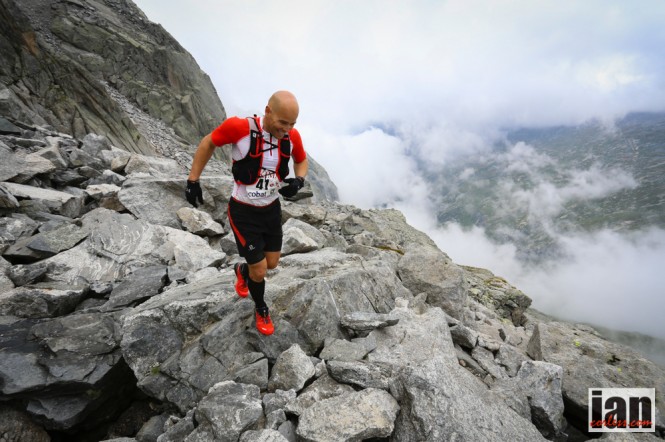
Kima Skyrace 2014 ©iancorless.com

